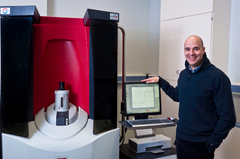New technology in the magnetic cooling of chips
A team of CIC nanoGUNE researchers has participated in the development of a new technology that will enable the environmental impact to be minimized. The work has been published in the prestigious journal Nature Materials.

Luis Hueso, a nanoGUNE researcher, together with researchers from the University of Cambridge, among others, has developed a new technology in the magnetic cooling of chips based on the straining of materials. Compared with the current technologies, this advance enables the impact on the environment to be lessened. The work has been published recently in the prestigious journal Nature Materials.
Current cooling systems, be they refrigerators, freezers or air conditioning units, make use of the compression and expansion of a gas. When the gas is compressed, it changes into a liquid state and when it expands it evaporates once again. To evaporate, it needs heat, which it extracts from the medium it touches and that way cools it down. However, this system is harmful for the environment and, what is more, the compressors used are not particularly effective.
One of the main alternatives that is currently being explored is magnetic cooling. It consists of using a magnetic material instead of a gas, and magnetizing and demagnetizing cycles instead of compression-expansion cycles. Magnetic cooling is a technique based on the magnetocaloric effect, in other words, it is based on the properties displayed by certain materials to modify their temperature when a magnetic field is applied to them. However, the applying of a magnetic field leads to many problems in current miniaturized technological devices (electronic chips, computer memories, etc.), since the magnetic field can interact negatively owing to its effect on nearby units. In this respect, the quest for new ways of controlling the magnetization is crucial.
Magnetism without magnetic fields
The researchers Luis Hueso, Andreas Berger and Odrej Hovorka of nanoGUNE have discovered that by using the straining of materials, they can get around the problems of applying a magnetic field. “By straining the material and then relaxing it an effect similar to that of a magnetic field is created, thus inducing the magnetocaloric effect responsible for cooling,” explains Luis Hueso, leader of the nanodevices group at nanoGUNE and researcher in this study.
“This new technology enables us to have a more local and more controlled cooling method, without interfering with the other units in the device, and in line with the trend in the miniaturization of technological devices,” adds Hueso.
20-nanometre films consisting of lanthanum, calcium, manganese and oxygen (La0.7Ca0.3MnO3) have been developed. According to Hueso, “the aim of this field of research is to find materials that are efficient, economical and environmentally friendly.”
“The idea came about at Cambridge University and among various groups in the United Kingdom, France, Ukraine and the Basque Country we have come up with the right material and an effective technique for cooling electronic chips, computer memories and all these types of applications in microelectronics. Technologically, there would not be any obstacle to using them in fridges, freezers, etc. but economically it is not worthwhile because of the size,” stresses Hueso.
Today, most of the money spent on the huge dataservers goes on cooling. That is why this new technology could be effective in applications of this kind. Likewise, one of the great limitations that computer processors have today is that they cannot operate as fast as one would like because they can easily overheat. “If we could cool them down properly, they would be more effective and could work faster,” adds Hueso.
Dr. Hueso stresses that this is a very interesting subject with respect to future patents.
Original publication:
Giant and reversible extrinsic magnetocaloric effects in La0.7Ca0.3MnO3 films due to strain
X.Moya, L.E. Hueso, F. Maccherozzi, A.I. Tovstolytkin, D.I. Podyalovskii, C. Ducati, L.C. Phillips, M. Ghidini, O. Hovorka, A. Berger, M.E. Vickers, E. Defay, S.S. Dhesi and N. D. Mathur.
Nature Materials 12, 52 (2013). DOI: 10.1038/NMAT3463.
Luis Hueso
Nanodevices Group
CIC nanoGUNE
Tolosa Hiribidea 76 E-20018 Donostia – San Sebastian
l.hueso@nanogune.eu
